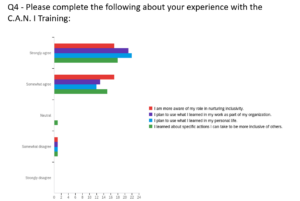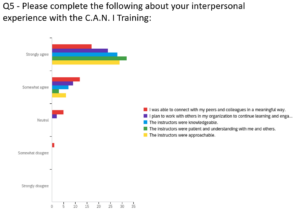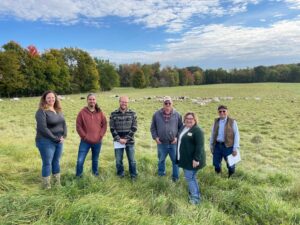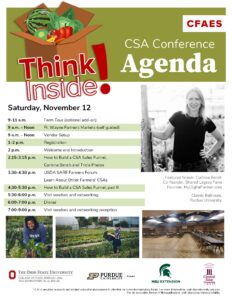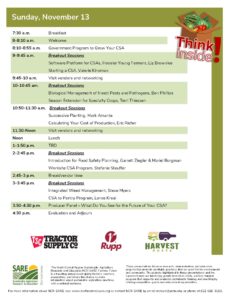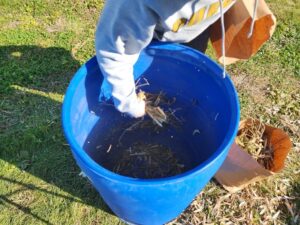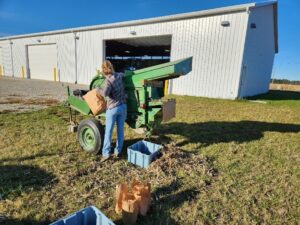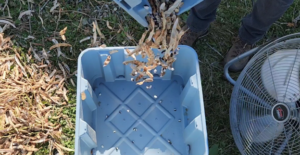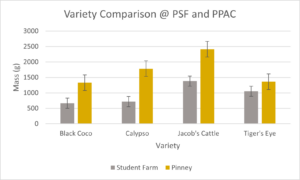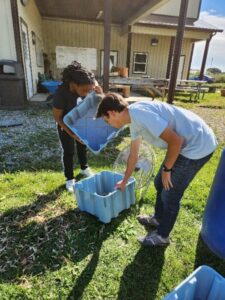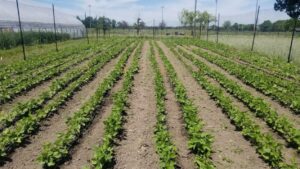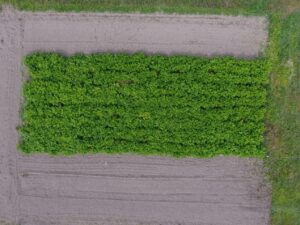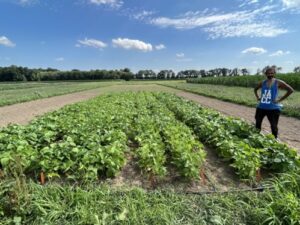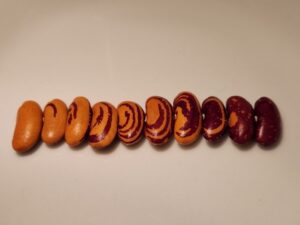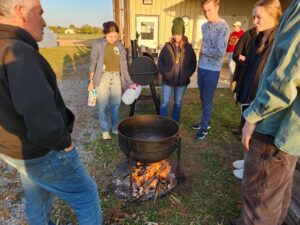Final report for WNC20-102
Project Information
Indiana SARE program continues to reach its stakeholders despite COVID-19 restricting much travel and many of our activities, including planned events. We have used technology to reach our stakeholders, including using funds to facilitate digital and online delivery of information which we continued into 2022.
Indiana will continue to move toward the implementation of sustainable agriculture practices. Indiana is a leader in adopting cover crops and other soil health-promoting practices, integrated pest management strategies, pollinator protection practices, urban farming, diversified farming systems, and local food production.
Additions of specialist positions in Soil Health/Cover Crops, Beginning Farmer Coordinator, the addition of a Statewide Food Safety Educator, a statewide Urban Agriculture Coordinator, Organic/Diversified/Urban Ag Educators, and the growth of the Indiana Small Farm Conference as a means of outreach to a previously largely underserved audience are all signs of the evolution that is underway and evidence of Indiana’s awakening to the concept of sustainable agriculture.
The Indiana SARE PDP program continues to extend its reach to new audiences and engage new groups of educators in its programmatic efforts. The SARE Advisory committee is increasing the diversity of its representation and continues to seek suitable talented, and passionate representatives. This Plan of work is a direct representation of their commitment and collaboration. New partners, the Indiana Department of Health worked with Indiana SARE to bring four webinars to help train Indiana Food Council. another new partner is the National Wildlife Federation and the Indiana Association of Soil and Water Conservation Districts and their program Urban Soil Health Program.
Indiana is fortunate to have a formalized collaboration of Agency partners committed to conservation, the Indiana Conservation Partnership, and IN SARE is the beneficiary of this collaboration.
Efforts have begun to expand the reach to youth educators across Indiana, specifically ag education instructors and FFA teachers, to build awareness of SARE, better assess their needs, share resources, and find ways to engage the next generation of farmers.
It remains a primary goal of the Indiana SARE Coordinator to not only expand the communication with these separate groups and to identify and foster ways to foster additional cooperation in program delivery but additionally to identify others in Indiana who may be serving in these capacities in smaller perhaps more local ways. Outreach to staff in other Indiana Colleges and Universities interested in sustainability is underway.
The Small Farm Conference continues to serve as a much-needed focal point for small farms and sustainable agriculture in Indiana but also an evident commitment to these subjects from multiple partners coming together to make something special happen. Conventional farmers experiencing low commodity prices are seeking information on various related topics.
The Purdue Small Farm Team, the Diversified Farming and Food Systems program, and the IN SARE Advisory Council work collaboratively. The decision-making body for the IN SARE PDP effort will be the members of the SARE Advisory Council (AC), who will collaborate and be supportive of the professional development efforts of the Purdue Small Farm team in addition to other professional development needs identified by the AC.
The following initiatives were identified, discussed, and approved by the IN SARE Advisory Council at their September 7, 2018, meeting, further refined by Initiative Teams, and then approved by the full AC:
2021-2022 Indiana state initiative topics
- Structural Support for Food and Agriculture
- Crop and Livestock Diversification Practices to Enhance Regenerative Agriculture and Food Systems
- Integrated Approach to Natural Resources
- Addressing the Needs of Underserved Audiences in Agriculture and Food Systems
- Beginning Farmer and Rancher Regional Initiative
State initiatives for 2021-2022 are:
Initiative 1: Structural Support for Food and Agricultural Systems
- More than 100 organizations, hospitals, foundations, clinics, and educators contacted to contribute to a common database.
- Convene affinity groups to identify educational needs and channels.
- Host or travel to two pieces of training for up to 60 professionals.
- Convene regular meetings on Food is Medicine topics with targeted groups across Indiana including elected officials and others interested in learning more about how locally grown food can contribute to a healthier Indiana.
Initiative 2: Crop and Livestock Diversification Practices to Enhance Regenerative Agriculture and Food Systems
- A total of 30 educators will attend the 2021 and 2022 Indiana Small Farm Conference
- 40 educators and stakeholders will attend trainings offered with Pasture Project and Savory Institute. Includes introductory webinar(s), and in-field learning activities at host farms.
- Training on regional livestock processing and network formation pertaining to livestock processing
- 10 educators’ Field trip to Indiana and Kentucky for 10 educators’ - hair sheep and goat training.
- Workshop on digital methods for livestock production
- Training for Extension educators about absentee and investment landowners; how they can help facilitate the conversation from conventional agriculture to a regenerative/holistic farming.
Initiative 3 - Integrated Approach to Our Natural Resource
- Training programs in
- Basics of Soil Health podcast 12/year (2021/2022)
- Advanced Soil Health Systems Training 4 per year (2021)
- Advanced Cover Crops Training (Commodity Crop Emphasis) - 4 per year (2022)
- Demonstrating Cover Crop Use and Reduced Tillage in Specialty Crop Pumpkin, Corn and Watermelon Production (2021, 2022) A portion of this budget is found under salary and fringe spreadsheet
- Cover Crop and Soil Health Training at Indiana Horticulture Congress (2021/2022)
- Education/Presentation Skills Development for Educators and Peer-Based Mentors (2021/2022)
Initiative 4: Addressing the Needs of Underserved Audiences in Agriculture and Food Systems in Urban Farming Systems
- Three in-state farm viability tours each year (2021, 2022)
- Midwest Learning field trip to Detroit, MI. (2021)
- Five ag professionals will be sponsored to attend the Small Farm Conference hosted by Purdue Extension in 2022.
- “Best Practices” video series. These videos will be shared during the Indiana Small Farm Conference, in programming curriculum from Purdue Extension, and through online public platforms such as YouTube and social media. These videos will be created throughout the farm tours activities.
Initiative 5: Beginning Farmers and Ranchers-Regional Initiative
Advisors
- (Educator)
Education
Initiative 1: Structural Support for Food and Agricultural Systems
In Indiana, there is strong interest from public health leaders and educators to incorporate healthy, local food into preventative and treatment programs for patients, and to engage with the community through gardening and healthy lifestyle choices. Often hospitals, clinics, doctors, health coalitions, and educators are not well-versed in the research and evidence-based programs that use local food to educate the public. Hospitals, clinics, and health foundations are interested in investing in food systems for a healthier Indiana but lack the education, training, and connections to each other to make things happen. Structuring a health care system that fosters a healthy food culture will support Indiana’s sustainable food producers and businesses and yield long-term impacts in communities. This initiative will focus on identifying programs that connect local food to health, educational needs, training for medical professionals, and growing collaborations across the state.
Initiative 2: Crop and Livestock Diversification Practices to Enhance Regenerative Agriculture and Food Systems
Educators need the training to support the diverse needs of farmers, landowners, and processors in Indiana. This encompasses context-specific principles at the farm level with diversified crop and livestock systems, regional processing infrastructure and regulatory compliance, and landowner engagement. Training is categorized as follows, 1) systems thinking for regenerative farming success or 2) regional infrastructure and market development for farm diversification and regenerative regional farm economies.
Initiative 3 - Integrated Approach to Our Natural Resource
Indiana remains a leader in soil health practices and cover crop adoption. The various levels of knowledge across the state provide a need for a tiered training program for professionals and specialized training for specific production models. Each program focuses on the environmental and economic sustainability of soil health practices while touching on the social aspects of these practices.
Initiative 4: Addressing the Needs of Underserved Audiences in Agriculture and Food Systems in Urban Farming Systems
Indiana’s practice of urban agriculture has greatly expanded in the past several years, partly in response to the increasing difficulty of accessing fresh, healthy food in urban areas. But there is still much to do in this arena, particularly in addressing the needs of farmers of color. Urban agriculture work differs from rural agriculture in terms of the land base, social structure, mission, and growing methods. Resources for urban agriculture must be tailored to these unique characteristics, requiring those supporting this work to have a broad knowledge base and skills distinct from what was required to support rural agriculture enterprises. Additionally, this support must be provided with respect to long-standing social inequities and injustices impacting underserved urban communities, particularly those of people of color.
Initiative 5: Beginning Farmers and Ranchers-Regional Initiative
Continued efforts are needed to increase our capacity to work with beginning farmers and ranchers. We are particularly concerned about those who are underserved by Purdue Extension and USDA programs. As such, efforts are needed to encourage working with BIPOC, military veterans, and women farmers. During the two-year plan of the work period, we will offer additional SARE-funded travel scholarships, and where appropriate, mini-grant support to further educational programming that increases the sustainability and success of underserved beginning farmers and ranchers.
Education & Outreach Initiatives
Objective A: Establishing an Indiana Food Council from the Ground Up:
The primary goal of this project is to engage our food councils in a two-year long process of self-reflection, peer to peer learning, and learning from farmers and professional development Please note that this part of the project overlaps with Initiative 4: Addressing the needs of underrepresented audiences in agriculture and food systems.
Objective B: School garden network development Provide 5 Extension Educators and 5 K-12 Teachers with travel scholarships to attend an intensive school garden training program and learn more about sustainable school garden management and network development.
Objective C: More than 100 organizations, hospitals, foundations, clinics, and educators contacted to contribute to a common database.
Objective D: Convene affinity groups to identify educational needs and channels.
Objective E: Host or travel to two trainings for up to 60 professionals.
Objective F: Convene regular meetings on Food is Medicine topics with targeted groups across Indiana including elected officials and others interested in learning more about how locally grown food can contribute to a healthier Indiana.
Objective A: Establishing an Indiana Food Council from the Ground Up:
40-50 Food Council Members will engage, learn and network at a statewide level for a period of two years (minimum) to increase their understanding of the tools, resources and information available to help them assess their community food system. This group will formalize an Indiana Food Council with representation from the local and regional food councils from across Indiana. Draft of a Food Charter or Farmers Pledge for Indiana that prioritizes sustainable agricultural practices. Events and activities related to this initiative included:
Statewide Food Policy Council Organized
Objective B: School garden network development
25 Extension Educators trained to provide professional school garden network support to educators and schools in Indiana. 25 K-12 Teachers introduced to school garden concepts, benefits, and management options.
Objective C: More than 100 organizations, hospitals, foundations, clinics, and educators contacted to contribute to a common database.
Objective D: Convene affinity groups to identify educational needs and channels.
Objective E: Host or travel to two trainings for up to 60 professionals.
Objective F: Convene regular meetings on Food is Medicine topics with targeted groups across Indiana including elected officials and others interested in learning more about how locally grown food can contribute to a healthier Indiana.
Objective A: Establishing an Indiana Food Council from the Ground Up:
63 Food Council Members engaged, learn and network at a statewide level to increase their understanding of the tools, resources, and information available to help them assess their community food system through a series of four C.A.N.I trainings with Dr. Byron Martin and Janelle White. Indiana State Department of Health partnered with Indiana SARE to bring the four webinars that had a total of 129 people who attended them all, with 63 unique individuals from Purdue Extension, Indiana Department of Health, and many other Food Council members representing Food Networks across the state of Indiana. An evaluation showed the majority of Food Council members learned new knowledge of nurturing inclusivity and plan to use it in their organizations.
The evaluation also showed that most Food Council members could connect with their peers and colleagues in a meaningful way (despite being an online series) and plan to work with others in their organization to learn and engage in nurturing inclusivity.
Objective B: School garden network development
3 Purdue extension educators traveled to Texas and were trained to teach the Texas A&M Junior Master Gardner (JMG) program to schools and other youth in the community. Supplemental books were purchased with SARE funds to build their library as these educators reached out to their communities.
The educators learned the new JMG curriculum and also all of the following regarding JMG and youth gardening: program evaluation, funding options, program partnerships, program implementation, leadership, and program sustainability. This was done through hands-on lessons, garden activities, demonstrations, garden tours, concurrent sessions, and keynote speakers. Networking with other teachers, leaders, and extension staff is a huge part of the program as well. One of the goals as a Purdue team was to be able to do train-the-trainer workshops when we returned home.
Utilizing the resources and information gained from the 2020 JMG National conference, two of those educators hosted a 4-week JMG series for 14 elementary students in the summer of 2021. Purdue Master Gardener volunteers assisted with the series and were trained to host the program in the future.
In May and June, 2022, Junior Master Gardeners books were passed out throughout the state at three all-day train-the-trainer events taught by Dr. Katherine Orvis for training educators and ag professionals working with K-12 students. Ft. Wayne, Greenfield, and Evansville were host sites for training that covered the state's geography, with 32 educators being trained and outfitted with books of the primary curriculum for Junior Master Gardeners.
Objective C: More than 100 organizations, hospitals, foundations, clinics, and educators were contacted to contribute to a common database. Indiana SARE is working with multiple partners and organizations throughout the state to learn about existing activities in Indiana for food as medicine. An inventory through the Indiana Nutrition Incentives Network is being performed to establish a database and online map to share initiatives with others. The map is in the process of being produced. Work should be mostly done in 2023.
Objective D: Convene affinity groups to identify educational needs and channels. This initiative is working on a plan to convene affinity groups, but we may pivot and provide a platform for convening mixed groups (that will pollinate each other and help to make network connections) to learn and share together and from one another. Looking for a Fall 2022 training timeframe.
The Indiana Food is Medicine Symposium, sponsored by Indiana SARE PDP, Indiana University, Eskenazi Health, and Piazza Produce, assembled more than 90 professionals from 9 food system sectors in the public and private, and nonprofit sectors. More than 50 organizations were represented, with attendees working in community organizing (11), advocacy (8), direct education/programming (9), food services (1), farming/food business (6), research (6), public health (28), and practitioners in medicine (14) and dietetics (8). On December 1, 2022, this full-day symposium presented lectures on food and brain health, ultra-processed foods, procurement of local foods, equity in the food system, food systems to address public health issues, and farmer-driven food is medicine programming. Attendees participated in mind-body breaks and were served lunch and breakfast, including locally procured, healthy foods. "Eat to Beat Depression and Anxiety" book was bought for each participant.
Reviews of the event were very positive, with information learned, connections to others made, and initiative being taken by participants. We will continue to convene those interested in food is medicine for Indiana and launch a directory of people leading and learning in different ways to continue connections. We are deeply grateful to Indiana SARE PDP for this opportunity, and the two years of relationships and preparation for this event, which will now have a strong foundation for continued attention and leadership from around the state.
Learning Objectives
- Increase understanding of healthy food impact on mind and body for practitioners working directly with patients, including those with depression, and co-morbidities
- Increase awareness and understanding of racial inequities in health and how engaging in multi-sector, food system-oriented programming, conversations, and initiatives with equitable approaches are critical.
- Increase awareness of programming and initiatives around Indiana and engage with community-based approaches to food is medicine.
This was the agenda for the symposium:
|
Morning Agenda |
||
|
8:00-9:00 |
Registration |
Host: Seth Grant |
|
9:00-9:10 |
Welcome |
Dr. Lisa Harris, CEO of Eskenazi Health |
|
9:10-9:15 |
Mind-body Medicine |
Brent Anderson, Indiana Department of Health |
|
9:15-9:20 |
White House Conference on Hunger, Nutrition and Health and National Strategy |
Jodee Smith, Indiana University |
|
9:20-9:30 |
Indiana support for Food is Medicine |
Dr. Lindsay Weaver, Indiana Department of Health |
|
9:30-10:30 |
Keynote: Nutrition and Mental Health |
Dr. Drew Ramsey, Columbia University College of Physicians and Surgeons |
|
10:30-10:45 |
Mind-body Pause |
|
|
10:45-11:00 |
Indiana Innovation: FAITH Food is Medicine |
Pastor Curtis Whittaker, FAITH Farms |
|
11:00-12:00 |
Social justice and public health - why a systems level and equity centered approach is critical for public health |
Jill English - Child Advocates, Inc. Naima Gardner-Rice – Indiana Department of Health |
|
12:00-12:30 |
Lunch |
|
|
Afternoon Agenda |
||
|
12:30-1:30 |
Keynote: Culinary Medicine and Ultra Processed Foods |
Dr. Michael Fenster, The University of Montana |
|
1:30-1:45 |
Mind-body Pause |
|
|
1:45-2:00 |
Indiana Innovation: Food is Medicine for NW Indiana |
Melissa Mitchell, HealthLinc |
|
2:00-2:30 |
Food is Medicine Policy at the Federal Levels and Implications for State Action |
Katie Garfield, Center for Health Law and Policy Innovation of Harvard Law School Brent Ling, Wholesome Wave |
|
2:30-2:40 |
Mind-body pause |
Brent Anderson |
|
2:40-2:55 |
Indiana Innovation: Importance of Regionally produced food procurement |
Seth Grant, Eskenazi Health |
|
2:55-3:15 |
Innovation: Food is Medicine |
Dr. Deanna Reinoso, Eskenazi Health |
|
3:10-4:00 |
Reflection and Discussion: Exploring our take-aways for the day, partnering on food is medicine initiatives, and next steps for engagement |
Dr. Julia Valliant, Indiana University |
|
|
|
|
|
4:00 |
Adjourn |
|
9 Sectors of the Food System representing the public, private and nonprofit sectors:
11 – Community Organizing
8 – Dieticians
9 - Direct Education or Programming
6 – Farm or Food Business
14 – Physicians
1 – Food Services
8 – Policy/Advocacy
28 – Public Health
6 - Research
Here are some quotes from the feedback survey,"I completely agree with Dr. Chef that nutritious food must taste good! I was unaware of the food as medicine mental health connection. This is exciting news that I will definitely continue researching." and, "I really liked the slide on Food Insecurity Screening "Hunger Vital Signs" from Dr. Reinoso's presentation. I work primarily as an outpatient dietitian in a bariatric clinic and could see how this type of screening could help me better address food insecurity challenges." with people deciding to implement new actions, "...I feel I now have additional, documented support for the food as medicine concept that will be helpful in grant writing. " and, "Ask about including food insecurity questions in our employee wellness surveys - they are private from our employer (only wellness employees see on a confidential basis), so may present a safe space for employees to ask for assistance in a dignified manner. " and new networking feedback, "Several, I intend to meet with one IDOH team member and email the Dr. Ramsey for more information. " and "Met new people and also re-connected with some people. I will be following up with some people I met who might be helpful if my organization decides to implement a food is medicine program." with overall feedback including, "Loved the mix of faith-based, state run, for profit and not for profit organizations - reflects what is needed to tackle the Food Is Medicine initiative - collaboration. " and,"I loved every single second of it! The food was amazing. The speakers were all fantastic. Yes - the pediatrician made me cry. This is just such an impactful, important endeavor. Thank you all.". the survey asked about future thoughts on continuing education with feedback such as, "Virtual events quarterly would be informative. Various times throughout the day. " and, "Yes to any? More statewide conversations focused on a whole range of FIM approaches. Conversations convened with leaders in insurance, Medicaid, medical systems."
Objective F: Convene regular meetings on Food is Medicine topics with targeted groups across Indiana including elected officials and others interested in learning more about how locally grown food can contribute to a healthier Indiana. Indiana SARE, partnering with Indiana University Sustainable Food Systems hosted a week of online conference sessions and hosts the recordings for Food as Medicine on the Indiana University Sustainable Food Systems website https://sfss.indiana.edu/projects/indiana/inuplands/conference2022.html. January 2022.
Objective A: A total of 30 educators will attend the 2021 and 2022 Indiana Small Farm Conference
Objective B: Sustainable Integration of Livestock on Cropland Workshops
Objective C: Effective Communication of Animal Welfare Issues & Certification Opportunity
Objective D Organic Small Grains Educational and Planning Day at Purdue University
Objective E: 40 educators and stakeholders will attend training offered with Pasture Project and Savory Institute. Includes introductory webinar(s), and in-field learning activities at host farms.
Objective F: Training on regional livestock processing and network formation pertaining to livestock processing
Objective G: 10 educators’ Field trip to Indiana and Kentucky for 10 educators’ - hair sheep and goat training.
Objective H: Workshop on digital methods for livestock production
Objective I: Training for Extension educators about absentee and investment landowners; how they can help facilitate the conversation from conventional agriculture to a regenerative/holistic farming
Organic farming practices can not only provide a more sustainable future for agriculture, but can also offer farmers an increase in profit, and better quality of life. This initiative fills the need for training and educational opportunities for educators, specialists, and district conservationists across the state to support farmers who may be looking to transition acreage to organic and more sustainable practices for their farm.
Participating educators and specialists will increase their knowledge about small farm production, marketing, and management practices and the challenges and opportunities that face small farmers in Indiana. Educators will attend day-long workshops or field trips and 2-day conference sessions and trade show, participate in small group discussions with invited speakers, and be provided with appropriate reference and resource materials.
Events and activities related to this initiative included:
Small Farm Education Field Day August 2021 Purdue Student Farm 1340 Cherry Lane West Lafayette, IN This Purdue Small Farm Educational Field Day emphasized sustainability in small-scale fruit and vegetable production regarding plant health and business management.
Objective A: Indiana Small Farm Conference
Richard Perkins was a speaker at the 2021 Indiana Small Farms Conference, 15 Purdue Extension educators attended.
This was moved to an online format due to Covid.
Liz Brownlee, owner of Nightfall Farms, and Genesis McKiernan-Allen were speakers for the 2022 Small Farm Conference online due to Covid, 16 educators attended.
Objective B: Sustainable Integration of Livestock on Cropland Workshops - Postponed due to covid. Will be in planning for this again.
Objective C: Effective Communication of Animal Welfare Issues & Certification Opportunity
Meat consumers are becoming more receptive to companies that certified animals had been raised humanely. There is a desire for more knowledge about the meat they are consuming. Multiple organizations and companies have developed a myriad of programs for animal care. Confusion exists about these programs and the steps being taken to certify livestock producers are complying. Educating educators on these programs will synergize the spread of knowledge to producers and the public.
Purdue Extension Educators and an Animal Science Animal Behavior and Well-being specialist developed two 1.5-hour live video programs for other Extension Educators, Agriculture teachers, and other government employees entitled “Labels Matter: The What, Why and How of Animal Welfare Certification.” The first session featured the Purdue specialist speaking on the basics of Human Certification. The second session contained three individuals representing companies that have human-certified products and another person who is an independent auditor for various programs. The two sessions averaged 44 people.
A tour of three farms in Northern Indiana that are humane animal certified was held for participants. These tours featured two industry representatives that spoke on how a grass-fed organic dairy farm and two organic poultry farms conducted business to meet the Humane Certification standards.
A survey was conducted of the participant with 24 responses. Of those, 92% reported that “this program has enabled me to gain confidence in my abilities to work with clientele that have an interest in Humane Certification, and this program has encouraged me to become more educated about Humane Certification.” Expressing a desire for more information on this topic was 87%. One mentioned, “I feel animal welfare is a hot topic, and the more we can learn to ensure we can best protect our producers from those who don’t like or understand animal agriculture would be great focus topics.”
When asked how they plan to use the material presented, multiple Agriculture Teachers responded with answers similar to” I plan to use the information in my Animal Science class to educate high school students about animal welfare” and “I will integrate the information within the Animal Science lessons on animal welfare/rights and careers.” Extension Educator responses included “I'm a new Educator with no animal/livestock experience. This information was an introduction for me to animal welfare and very helpful!” Several Educators said they plan to utilize this information working directly with farmers. Government employees responded with comments like, “I did not know anything about animal welfare before the workshop. After participating, I feel more confident to complete projects with my ISDA internship and to have a proper animal welfare focus when continuing my education at Purdue.”
One participant remarked,” Great presentations and I learned a lot which will help me work with my producers even more as they begin to address topics such as the ones that were addressed in the presentation.”
Following the tours, one participant remarked:
- I will be more informed and equipped to answer clientele questions about animal welfare certification and animal welfare principles
- I will be more informed and equipped to answer questions and explain animal welfare certification principles in plan commission meetings as the need may arise.
- I am more confident and comfortable with information about animal welfare as an educator.
Another stated: I will use the information to compare conventional farms to organic farms and learned about all the hoops they need to jump through to put the labels on the packaging.
Objective D: Organic Small Grains Educational and Planning Day at Purdue University In planning stages due to a new organic specialist to the position.
Had training at North East Purdue Agricultural Center (NEPAC) in August 2021
A growing number of organic livestock producers in northern Indiana and Wolcottville Organic Livestock Feed (WOLF) Co-Op, a business designed to handle organic grains just 40 miles north of Whitley County, creates a potential opportunity for regional producers looking to diversify their crop production. Those willing to convert specific fields on their farms to USDA Certified Organic through USDA’s National Organic Program have the potential to meet a demand for organic grains and capture potential price premiums.
Purdue Extension Educators in Area XI and campus specialists worked together to offer the first-ever organic field day at Northeast Purdue Agricultural Center (NEPAC). NEPAC had recently converted one of their fields to USDA Certified Organic grain production, and the farm superintendent could describe what they have learned so far. Sessions included: what can I expect from an organic inspection, disease management in organic field crops, marketing organic grain, field demonstration plots on weed control, interacting with organic grain farmers, and networking time. The interaction with the organic grain farmer included a description of his processes and challenges throughout the growing year, including equipment on display that he uses, his battles with weed control, and his use of cover crops.
Of the 26 participants in attendance, 13 completed the post-survey. Twelve farmers and 14 Extension Educators, specialists, or speakers attended the event. Of the farmer attendees, six were male, five were female, and one did not list gender. Eight were non-Hispanic. Ten were white, and one preferred not to answer. There was a nearly equal representation of ages from 18-69.
As a result of the NEPAC Organic Field Day, 84.6% of respondents indicated (agree or strongly agree) that they learned something they didn’t know before. When asked if this field day increased participant awareness of opportunities in organic grain production, 92.3% of respondents indicated “agree” or “strongly agree.” As a result of attending the field day, half of the respondents indicated that they plan to adopt practices in creating, improving, or strengthening businesses for diversified farming and food systems. A quarter of participants indicated they plan to adopt recommended field crop practices, including fertilizer and/or pesticide practices, practices for their farm/operation, and management practices. The field day contributed to increased participant knowledge of organic grain production, and as a result, participants reported they plan to adopt practices in creating, improving, or strengthening business.
Educators with the organic specialist planed the Organic Small Grains training for February of 2023.
Objective G: Training on regional livestock processing and network formation pertaining to livestock processing
A training occurred for Extension educators in May 2021 to show how to process meat at the Purdue meat facility led by Stacy Zulily. Educators learned a lot and want to bring the information back to their counties to share with their stakeholders. One wanted to give a presentation on sausage making.
Objective H: 10 educators’ Field trip to Indiana and Kentucky for ten educators’ - hair sheep and goat training.
Elysia Rogers and Mark Kepler planned a 2022 SARE trip as outlined below:
October 5:
1 PM-Arrive at United Producers Stockyards in Manchester, MI-
2:15 PM-Leave and travel to the local feedlot that supplies lambs to United Producers. This feedlot sells about 5,000 lambs per year.
2:45 PM-Tour Feed Lot
5:00 PM-Travel to Hotel and supper
October 6:
9:30 AM-Arrive at Berry’s Naturally for a pasture walk with Hair Sheep, Reading, MI
11:30 AM-Leave Berry’s Naturally
1:00 PM-Arrive at DCI&B Livestock for a Small, non-commercial goat dairy tour, Fremont, IN
2:30 PM-Travel home
Besides Elysia and Mark, Extension Educator Beth Vansickle, Jorge Lozoya NRCS, and Art Franke NRCS participated.
Doug Brooks led the United Producers Livestock Auction tour. He explained current marketing trends, lamb pools, tagging systems, marketing dates, to whom most lambs and goats are sold, and the influence of national trends and markets.
Doug then took us to a local lamb feedlot that purchases semi-loads of western lambs and feeds them out for his market.
We discussed marketing, death rate, breeds, feeding rations, diseases, time to market, and when to market.
We also toured a portable sheep shearing semi-trailer.
On the second day, we toured a grass-fed hair sheep farm. We extensively talked about grazing rotation, fencing, grass health, fertilization and nutrients, marketing, livestock nutrients, and the utilization of compost tea.
This was followed up by a dairy farm tour that utilized minimal space to grow a dairy herd. They sold animals for 4-H and used the milk to feed out dairy calves. They had several registered breeds available for use.
The following comments were gathered from participants on how this tour had expanded their personal growth:
I learned about marketing sheep and goats and some of the struggles within the industry.
I learned how to raise livestock naturally with management. Also, the benefits of raising two different types of livestock to fight parasites that can cause issues.
I also learned more about the dairy goat industry, which I knew little about before the tour.
This program opened my eyes to what is happening in the market for goats and lambs. I had no idea that western lambs were being brought to this area. I learned about feeding systems, hair sheep production and marketing, and pasture improvement methods.
I will use this information in the programs I present.
As a result of this SARE-sponsored tour, I have gained a better knowledge of the marketing side of raising small ruminants. Understanding the drive behind the markets and being able to target the raising of animals for the various ethnic holidays and what the buyer is looking for, will help my clients as a professional and my farm marketing.
I would say that I gained several valuable lessons from the Tour related to small livestock management and marketing.
The seasonality of the goat and sheep market and the uncertainness of the animal's destination when marketed is a challenge for producers. Anyone looking to get into this market should seek to understand this a little better. It will make a big difference if a goat and sheep producer can be successful or not. Seeking advice from experienced livestock producers and marketers already in the industry is important to gain knowledge.
I also learned about the various issues affecting animal health in this industry and how producers can address these issues. Promoting good genetics on the farm is important as is monitoring for animal health so that potential problems such as nutrient deficiencies and parasite issues can be caught early and addressed.
I also learned about the opportunities for rotational grazing using small and large livestock to optimize the available forage on a farm. This is a valuable lesson that I can use to help advise small farms with diverse livestock.
Although two planned objectives were not met, we reached ag professionals in our Crop and Livestock Diversification Practices to Enhance Agricultural Sustainability initiative in a few other ways in 2022.
First, our SARE Advisory council asked for training to learn how to reach farmers and have events in ways they value being contacted and communicated with helpful messages. The National Wildlife Federation is working on its own SARE grant to create a workshop and materials that meet this objective. They came for a pilot program in September 2022, and there were 18 ag professionals there hand-picked from various partner organizations across the state, including six extension educators, 1 Purdue horticulture specialist, Purdue organic specialist, Conservation Cropping Systems Initiative Program leaders, NRCS leaders, IASWCD leaders, and the Indiana Department of Agriculture leaders. This all-day meeting was informational on the psychology and models of middle adopters of sustainable topics, ways to help reach these farmers, and best practices for event planning and evaluation work. There was time, in the end, to do hands-on work on a project together and get feedback from each other and the leaders. The pilot program helped the organizers tweak their materials, and they met with some people after the meeting for feedback and thoughts to improve the program. Four Grow More Trainings are planned across Indiana in September 2023 with CCSI's partnership and planning.
Meigs Field Day Fruit Veg & Hemp July 21, 2022, had 118 attendees, with over 40 being ag professionals.
On Thursday, July 21, Purdue Horticulture Extension hosted the 2022 Purdue Fruit, Vegetable, and Hemp Field Day at Meigs Purdue Ag Center. Presenters from HLA included Petrus Langehoven, Miranda Purcell, Stephen Meyers, Peter Hirst, Jeanine Arana, Emmanuel Cooper, Luis Medina, Eduardo Miranda, Lian Durón, and Josué Cerritos. Other presenters included Nathan Shoaf (Purdue Extension Urban Agriculture State Coordinator), Janna Beckerman, Marguerite Bolt, and Eastyn Newsome from Botany and Plant Pathology and Laura Ingwell, Elizabeth Long, Leslie Aviles, and Samantha Willden from Entomology.

Indiana SARE collaborated with Ohio State University, Central State University, and Michigan State University to listen to the farmers who wanted to have a regional CSA conference. Our first in-person conference was in Ft. Wayne, Indiana, November 12-13. SARE sponsored a farmer's forum where three farmers (one from each state) shared about their SARE grants. Many farmers and specialists shared what they do on their CSA. It was a great conference, and many learned about SARE for the first time. A lot of great networking happened as well. Educators and ag professionals from all three states came, at least 15 from Indiana, to be trained.
Here is some feedback,"Every SARE event I attend is such a great opportunity to learn from and connect with other ag professionals and farmer leaders in sustainable agriculture. I gain so much. This program helps me provide the most relevant, applied programming for my stakeholders."
Dry Bean Research Summary 2022 – Exploring Large Grains on the Small Farm
By Ashley Adair, Extension Organic Agriculture Specialist
Introduction
Many farmers, especially beginning farmers, plan their farms around producing various perishable products that sell well, like tomatoes, peppers, and leafy greens. As farmers gain more experience and build their markets, they may wonder what other crops they can add to their crop rotation. Storage crops can be part of that plan, allowing them to extend their sale season and provide additional value to their customers. Storage crops might include winter squash, onions, and pumpkins. Another storage crop to consider is grain: flint corn, popcorn, wheat, or even dry edible beans, which are the focus of this project.
Stepping into the world of grain might seem daunting at first. The farmer might assume they need a lot of land, a combine harvester, large tractors, and complex planting equipment to ensure success. This project aims to dispel preconceived notions about grain production on a smaller scale and explore ways to make small-scale grain production viable for the small-scale grower. This project also seeks to discover which heirloom dry bean varieties are suitable for production in Indiana.
What are dry edible beans? Dry edible beans, or simply dry beans, are a food-grade storage grain crop. Dry edible beans come from the same type of plant that many fresh edible beans (i.e., green beans or fresh shell beans) come from, Phaseolus vulgaris. Many beans are available, and some varieties can be fresh or dry. They are most commonly grown as a food-grade crop and provide many nutritional benefits to those who consume them. They can also be incorporated into animal feed but are more lucrative in the food grade market, selling for as much as $60 per hundredweight (cwt) in the certified organic marketplace. Compare this to certified organic soybeans, which have sold for $35-40 per bushel in 2022, and require a growing season of as many as 20 days longer to mature.
Dry beans are a shorter-season crop, usually taking 80-90 days from planting to harvest. They prefer well-drained soil and are generally poor competitors with weeds. In organic management, dry beans require vigilance and much attention focused on mechanical weed control. Foxtails and other grasses are public enemy number one for this crop, but any weed will be problematic for growing these successfully. On the other hand, dry beans are a legume and can provide for much of their own nitrogen needs, even in soils that have relatively low organic matter, like the sandy soils where they prefer to grow. Dry beans are most commonly grown in the north-central states of the US, as well as Ontario, Canada. North Dakota is the number one producer of dry beans in the US, followed by Michigan, Nebraska, and Idaho. While these states differ in climate and weather patterns, they share some suitable soil types, rainfall amounts, grain handling infrastructure, and shortened growing seasons that make growing dry beans (versus soybeans) viable option for the commercial grain grower.
Many commercially available dry beans at the grocery store are limited to a handful of specific varieties. Commonly available to consumers are pinto beans, black beans, great northern beans, and kidney beans. But there are a considerable number of dry bean varieties available to the small-scale grower and market gardener that can’t readily be found at the grocery store. These varieties often are locally adapted to where they were bred rather than bred for adaptability to a large geographic area or mechanized harvest. In addition to local adaptability, each dry bean has a specific flavor, culinary characteristics, and cultural history that can help enrich the farmer’s and consumer’s kitchens while providing essential nutrients, such as fiber, protein, and several minerals, to the human diet.
Project description and design: A dry edible bean variety trial was installed at the Purdue Student Farm (West Lafayette, IN) and Pinney Purdue Agricultural Center (Wanatah, IN). Each site was planted in a randomized complete block design (RCBD) (see figs 1 and 2).
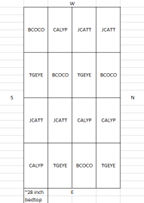
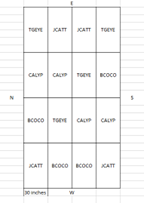
One of the largest differences between the two sites is soil type. The PSF features a silty clay loam, and Pinney PAC features a sandy loam. Other differences include cropping history and weather conditions. The PSF has been an organically managed (not certified), diversified vegetable farm since 2016. In contrast, the research plot used at Pinney PAC had been left unused and untreated for several years before the installation of this trial – which means a large weed seed bank. The trial was designed as a randomized complete block trial, meaning each “column” of the trial will feature all four varieties, randomly arranged. This type of design is common in agricultural research and helps to account for variability in the field where the trial is planted. Varieties used in this trial include the following:
- Black Coco – a type of black bean (determinate bush-type)
- Calypso – a type of black bean (determinate bush-type)
- Jacob’s Cattle – a type of kidney bean (determinate bush-type)
- Tiger’s Eye – a type of cranberry bean (indeterminate upright-type)
Varieties were selected based on several characteristics, including time to maturity, cultural relevance to the Midwest, common cooking preparations, and growth habits.
Materials and Methods
Each variety was planted using an Earthway seeder fitted with a pea plate in a double row at each site, each with about 18 inches of spacing between rows. Each block was 12.5 feet in length resulting in about 25 plants per block. Both sites were irrigated as needed using plastic drip tape to the equivalent of about 1 inch of rain per week. At PSF, beans were grown on shaped beds about 4 inches high. Hand labor was used to weed the beds. Each trial was side-dressed when bean plants had fully unfurled their second set of true leaves using an OMRI-listed pelletized poultry manure to the equivalent of 40 lbs. N per acre using an Earthway seeder fitted with a pea plate.
At PSF, the trial was planted on 6-3-22. Pinney was planted on 6-10-22 and due to inadequate irrigation, had to be replanted on 6-24-22. PSF was harvested over several days beginning 9-6-22. Pinney was harvested on 9-20-22 and 9-22-22. Harvest can occur as soon as dry bean pods are about 85% yellow and 15% brown or when beans are split in two when smashed with a hammer.
Dry beans must be threshed and winnowed to prepare them for weighing and sale. To develop recommendations and materials for demonstration, two threshing methods were used. Manual threshing was completed by flailing bean plants against the inside of a 55-gallon food-grade plastic drum. Mechanical threshing was done using a Swanson Machine Co. portable gas-powered plot thresher (see figs. 3 and 4).
Figure 3. Manually threshing whole dry bean biomass using a 55-gallon drum.
Figure 4. Swanson Machine Co. portable plot thresher being fed whole dry bean biomass.
Each method presented advantages and disadvantages: time commitment (hand threshing took as much as ten times longer) and expense devoted to purchasing and maintaining a machine (threshing machines can cost upwards of a few thousand dollars).
Whether threshed mechanically or manually, all dry beans still needed to be winnowed. Winnowing uses mesh screens or moving air to separate dry biomass from the beans. In this case, moving air was used to help simulate conditions and equipment available to a small-scale grower. A garage fan and solid-bottomed harvest bins were used. Video footage was procured from this process to instruct prospective growers further (available upon request). Fig. 5 shows part of this process.
Figure 5. Winnowing Calypso variety using a garage fan and harvest bins. Chaff is separated from beans while pouring biomass material from one bin into the other. The process is repeated until beans are reasonably free of chaff.
After harvest, the Purdue Student Farm site was flail mowed, and power harrowed using a BCS walk-behind tractor and corresponding attachments. A cover crop mix, including cereal rye and hairy vetch, was seeded at the Purdue Student Farm. The Pinney PAC site was disced under. Cover crops are planned for the area beginning in March 2023.
Preliminary Results
Dry beans were weighed by replicate in grams after threshing and winnowing were complete. Preliminary results are shown below. Variances were not pooled across sites.
Figure 6. Comparison of average mass (g) produced by each variety in each replicate at PSF (gray) and PPAC (gold).
It is unwise to conclude from a single year of data, but data combined with anecdotal experience in the field can yield some insight for future years. One of the major differences in performance between the two field sites was the performance of Calypso. Calypso performed poorly at the Purdue Student Farm and much better at Pinney. This may signal a strong response to well-drained soil conditions at Pinney versus poorly drained conditions and weed pressure at the Purdue Student Farm. The only other insight worth discussing is the apparently strong performance of Jacob’s Cattle at both sites.
2022 Deliverables
In 2022, the dry edible bean trial was involved in the following:
- Featured as a field stop at the Pinney Purdue Vegetable Field Day on 8/9/2022
- Utilized as a teaching opportunity in the lab section of the Small Farms Experience course (SFS 210), taking place at the Purdue Student Farm in September 2022
- Purdue Vegetable Season Pass (community-supported agriculture) participants (86 families) received about 1 pound of dry edible beans in their final share for the 2022 season. Feedback on using the beans will be collected in the Student Farm’s annual survey of CSA participants.
Future Plans
This trial will be repeated at both PSF and Pinney PAC in 2023. This will be the second and final year of the project, yielding two site years of data for analysis.
Future deliverables include, but are not limited to, the following:
- “Dry Beans – A Large Grain for the Small Farm?” presentation at the Indiana Small Farm Conference, 3/2/2023
- “Dry edible beans for the small scale producer” factsheet
- “Calibrating and using a push seeder to side dress crops on the small farm” extension publication
- Presentation during the Small Farm Education Field Day at the Purdue Student Farm in 2023
- Equipment demonstration videos
- BCS power harrow
- BCS flail mower
- Swanson plot thresher
- Manual threshing and winnowing of dry beans
- Using a push seeder to side-dress crops
Acknowledgements
First, I want to thank NC-SARE for providing the funding needed to conduct this variety trial and allow for exploring a crop not traditionally grown in Indiana.
Secondly, I want to think Dr. Liz Maynard, Clinical Engagement Professor of Horticulture, for her advice and collaboration. Her experience growing dry beans during her graduate studies and her willingness to share in the labor needs of this project were indispensable.
Others I would like to thank include the Purdue Student Farm, including Chris Adair, Farm Manager, and Alfonso Rosselli, former student production intern, for their assistance in installing and maintaining this project. Alfonso assisted in planting and installing irrigation at both field sites, as well as field maintenance. Chris and his farm crew ensured the crop was protected from wildlife using a deer fence and helped weed and schedule irrigation for the beds. I would also like to thank Dr. Petrus Langenhoven, Horticulture, and Hydroponics Crops Specialist at Purdue, for his advice and the use of his field equipment during the growing season.
Lastly, I would like to thank Dr. Steve Hallett, Professor of Horticulture, for inviting me to teach his Small Farms Experience course about dry edible beans and variety trials and instruct students during lab time about harvesting, threshing, and winnowing dry beans.
What follows are several more photos from the project and its deliverables.
Figure 7. Students in the Small Farms Experience course learn to winnow during lab.
Figure 8. Dry edible beans 21d after planting at PSF.
Figure 9. Aerial imagery sourced from Pinney PAC site on 8/2/2022. Crop progress was documented aerially at both field sites throughout 2022.
Figure 10. Momin Mirza, summer worker at Pinney PAC, stands at the dry bean plot after a long day weeding the bean plot. Photo provided by Liz Maynard.
Figure 11. Variation in appearance of Tiger’s Eye bean from several individual plants and pods from the 2022 season.
Figure 12. Dry beans from the 2022 trial were tested in a squash curry recipe at the annual Purdue Student Farm Organization banquet held October 20th, 2022.
Small Farm Field Day July 29, 2022, 43 people attended, with more than 10 extension educators and other ag professionals attending for professional development.
Purdue Experts led the following demonstrations at the event:
- Student farm packhouse tour and overview of good agriculture practices (GAPs)
- Weed identification and understanding thresholds
- Summer cover crops for weed suppression
- Infield soil diagnostics and soil health
- Vegetable disease, prevention, identification, and management
- Scouting for mites in high tunnel crops
- Black soldier fly composting
- Caterpillar tunnels
- and many more
Additional crop demonstrations will include beans, onion, sweet pepper, eggplant, and tomato varieties in various production systems.
This initiative meets the need for further education and implementation of cutting-edge sustainable soil health farm practices through collaborative training, travel scholarships, and other programs.
Indiana is a leader in sustainable cover crop practices. This initiative allows a place to channel the current knowledge base into a tiered training program for professionals, and specialized training for specific production models.
Events and activities related to this initiative included:
3 Soil Health Training Webinars, 2021 put on by CCSI
Demonstrating Cover Crop use in Specialty Production Summer 2021 going into Spring 2022
Soil health Podcasts - Specialty Crops with Hoosier Ag Today
Advanced Cover Crops Training for Ag Professionals - Soil Nexus Michigan September 2021
3 Soil Health Training Webinars, 2021 put on by CCSI, 155 Ag professionals from Purdue Extension and various other agencies attended to be trained.
Three plots demonstrating cover crop use in Specialty Production Summer 2021 going into Spring 2022
1. Pinney Purdue Ag Center, L. Maynard https://vegcropshotline.org/article/cover-crops-in-may-soil-health-podcast-on-spring-management-and-observations-of-winter-rye-at-pinney-purdue/
https://vegcropshotline.org/article/observations-of-sweet-corn-lodging-in-no-till-and-tilled-plots-at-pinney-purdue/
- Summer cover crops planted in ‘footprints’ of movable high tunnels
- Winter cover crops planted in ‘footprints’ and in high tunnels
- Summer planting was used as part of a presentation by P. Woolery at Aug. 10 Vegetable Field Day
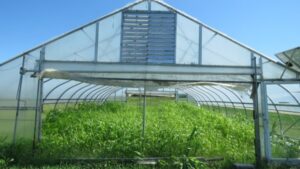
2. Meigs Hort. Res. Center, S. Meyers
- Oats, cereal rye, rape cover crops seeded Sept. 10, 2021
- Garlic planted into trench made in fall cover crops
- The demo will continue into spring
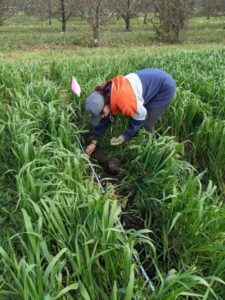
https://purdue0-my.sharepoint.com/:f:/g/personal/lmccartn_purdue_edu/EjfEaM_Yv4NCjaL1st1N1f0BGWUjsFLXC85mIzP2zbl0Hw?e=dH8Ooj is a timelapse video of Meigs Farm
Meigs Hort. Res. Center, L. Ingwell and J. Rorick
- Soil spaded prior to bed formation and laying plastic
- Buckwheat, oats, and no cover planted between beds and melons on beds
- In another demo, Milpa seed mix planted and time-lapse movie created
Soil health Podcasts - Specialty Crops with Hoosier Ag Today
Advanced Cover Crops Training for Ag Professionals - Soil Nexus Michigan September 2021
In August 2022, four Purdue Extension educators traveled to the Soil Health Nexus Training at University of Minnesota Southern Research and Outreach Center, 35838 120th St, Waseca, MN. Here is the impact to one of the newer educators, "
This training was worthwhile from beginning to end, including the lengthy travel time. As a new Educator, I was honored to be invited, and getting to know my ANR colleagues and specialists better has led to broader communication and opportunities for collaboration within the Extension Community. For example, I came to know a colleague through this trip, and when she left Extension recently, she passed some of the Invasive Species Signature Program responsibilities to me: She knew of my interest in and knowledge of invasive species through our experience traveling together.
At the conference, I had the opportunity to meet Extension Educators and Specialists from several Land-grant universities, including The Ohio State, MSU, U of Wisconsin-Madison, Nebraska, Iowa State, and North Dakota. By participating in the planning session for next year’s Soil Health Nexus event, I gained a greater understanding of specialties, tenures, and interests that make up the group.
Training curriculum was unique, in my experience. We were encouraged to consider extending the educational value of our experiences during consultations and field days by collecting media (video, photos, and audio) for use in future social media/AV projects. We even had the opportunity to create and present our own media at training’s end. Another useful training included the demonstration and discussion of tillage practices. It would be a rare circumstance in “real-life” that would have allowed me to see tillage ranging from no-till drill to mold-board plow, all within one day, side-by-side. I felt that my lack of understanding of tillage equipment was a barrier to effective communication with farmers, but now I feel a greater confidence when speaking with farmers about adapting current tillage practices to lower-disturbance options, its effect on the soil, and what that would entail financially and physically.
On day 2, the group was taken to several field trip locations, including a karst region runoff mitigation project on a wind farm and karst topography chosen to demonstrate nitrogen’s impact on groundwater. By traveling to this region and discussing how soil depth and structure affect management considerations and concerns, I gained a larger perspective on what purposes cover crops serve in the Midwest. Overall, this field training provided strengthened relationships, understanding of media education, and knowledge of soil health topics that I will carry forward in my Extension programming efforts."
Soil Health and sustainability for midwestern field staff (2022) June 21-23. One Purdue Extension educator went with travel funds.
This is an advanced soil health workshop for Indiana Conservation Partnership staff (NRCS, SWCD, Extension, ISDA, IDEM, IDNR, FSA) and other ag professionals who work one-on-one with farmers and landowners. Attendees will learn to teach others about soil health, its importance and diagnosis, along with practices to improve soil health. They will also learn what to look for in a soil pit and learn from a local farmer/Eisenhower Fellow about his excellent Conservation Cropping Systems. This training is made possible by CCSI, Indiana SARE, and the Soil Health Nexus. Beck Agricultural Center at the Agronomy Center for Research and Education, West Lafayette.
Pinney Purdue Vegetable Field Day August 17, 2022, 29 farmers and 6 educators attended
This was the agenda: Vegetable Farmers
Ashley Adair: Are dry beans an option
for Indiana Farmers?
Stephen Meyers and Jeanine Arana:
Weed Management in No-Till
Pumpkins
Wenjing Guan and Lyndon Kelley:
Drip Irrigation Equipment and
Scheduling
Marian Rodriguez-Soto and Tatiana
Gill: High Tunnels and Cover Crops
Laura Ingwell: Sweet Corn Insect
Management
*Pesticide Credits Will be Available
Vegetable Gardeners
Annetta Jones: Preserving Your
Produce
Phil Woolery: Cover Crops in Gardens
Nikky Witkowski: Irrigation Options
for Home Vegetables
Liz Maynard: Sweet Corn: USDA
Variety Trueness Test
Laura Ingwell: Sweet Corn Insect
Management
Pinney Purdue Agriculture Center has a power harrow that is being used to train ag professionals on how it can be used to prepare seed beds. This video showed work and training being done in 2022. Marian Rodriguez, Urban Soil Health Specialist, works with Phil Woolery and Liz Maynard to produce this informational training video on different cover crops, tools, and methods to terminate cover crops.
October 2022, SARE supported the Indiana Soil and Water Conservation District as they met at the annual professional development conference. There were 90 ag professionals there.
In October, Urban soil Health Specialists went to Lousiana to learn from Jessie Frost as he visited farms and shared his compost, planting methods and other soil health principles. The five ag professionals came back and shared with 62 ag professionals in an hour long presentation of highlights of what they learned. They will continue to train others and share their information across the state to promote backyard, urban and small market growers' sustainability.
Feedback from this included,"SARE assisted colleagues and me to participate in intensive soil health trainings for small farms. We took that information and have been conducting local and statewide workshops to disseminate the technical information and material. We also utilize what we learned to help the USDA-NRCS develop and implement their EQIP programs."
Underrepresented farmers need ag professionals’ help - which requires that ag professionals understand the products they grow, their marketing and financial strategies, their land access and financing options, their focus on community, and their emphasis on holistic farm management.
Begin Conversation with Land Trust Staff July, 2021 Zoom Webinar
Go to video 11 farmers for Farm Viability Tour Video Creation and their consultations on what issues they face as beginning and underserved diverse farmers.
Create the videos to share with ag professionals to train them in what farmers issues are and how we can better serve them.
Tours on hold due to Covid
Begin Conversation with Land Trust Staff July 2021 Zoom Webinar - Had about 40 people join on zoom to be trained from a Vermont land trust organization to help Indiana see the possibilities of land access and how Vermont handles that in their state.
Go to video 11 farmers for Farm Viability Tour Video Creation and their consultations on what issues they face as beginning and underserved diverse farmers. Paid a student videographer and she traveled the whole state to interview farmers on their farm to learn their specific dreams and what they face as beginning, underserved and diverse farms.
Create the videos to share with ag professionals to train them in what farmers' issues are and how we can better serve them. In the process of editing the videos. Here is a preview of one so far, it is not finished yet: https://app.box.com/s/9cd7ld2iy6nm32z9oohgppb1vgnvzvhe
Tours on hold due to Covid.
Trained ag professionals with the videos created. Had a training with 29 ag professionals watching and setting goals for the upcoming year.
Here are some feedback from Extension Educators, "I watched the four videos this afternoon. They are well done and certainly sheds a light on areas Purdue University, Purdue Extension and the state of Indiana can do better in. The small farmers, urban farmers and organic farmers need an easier time to succeed." with a new educator saying, "In the short 3 weeks that I've been an Educator with Extension, this event has given me the most motivation/direction about how to move forward! I am eager to do meaningful work in
my county!" and"It was a great conversation with farmers in videos and then to have a reaction with other educators and then have a facilitator give highlights. It was a pretty good inspiring meeting."
In November, Indiana SARE supported 21 ag professionals to meet in Fort Wayne to have a farm tour of Johnnie Mae Farm and a local mushroom farm. Twenty-one extension educators were able to be there for the day-long training and tours.
September 16th AORTA AORTA (anti-oppression resource & training alliance) training Seven ag professionals around the state were trained with feedback, "I just wanted to say thank you again for using the SARE PDP grant to make the AORTA training for Uprooting White Supremacy in Organizations happen for food systems leaders around the state. I participated in the September 16th training and found it to be extremely valuable to me as an individual in recognizing when white supremacy has taken root in an organization and provided me with concrete examples of what to avoid as I work to build a new statewide agriculture organization for the state of Indiana. The training covered interpersonal, institutional, and cultural manifestations of white supremacy in organizations and provided concrete ways to pivot towards better policies. This is a training that will impact me as a leader and my organization as a whole as we move forward to a better, more equitable future. I strongly recommend this training to others, not just in the food and farming communities, but to all organizations."
July 21, 2022 Agroforestry Merry Lea Environmental Learning Center 4415 W 200 S, Albion, IN 46701
35 people with at least 7 ag professionals attending and learning
- AGENDA
- 8:30am - Check in
- 9am – 11:30am – Farm Tour and summer grafting / pruning demo
- 11:30 – 1pm – Lunch - included- Sponsored by SARE.
- 1 – 4pm – Design Charette
- LUNCH
- We are serving a vegetarian wrap for lunch.
- If you have other dietary restrictions, let us know by Wednesday 13th this week!
- Thank you to North Central SARE for sponsoring!
- RESOURCES
- If you can before you come, download (free) and take a look at some of Savanna Institute resources, especially pages 21-40 of the second link below – Planting Tree Crops pdf.
- https://www.savannainstitute.org/resources/
- https://www.savannainstitute.org/planting-tree-crops/
- BRING
- Computer / phone – if you’d like to look up your property and soil maps. We will have a printer that you can print materials day-of at the event to help the design charette.
- Any other property maps / materials that would be helpful for you to think about your context / farm and where adding agroforestry will make sense (past surveys, past soil tests, sun maps, property lines, google maps aerials, etc).
- Water / weather-appropriate clothes (we’ll be outside for 2.5 hours for tour and pruning)
- Feedback included, "The agroforestry day was my first introduction to the topic and the subjects presented were done well. I enjoyed the hands-on demos and the content was not overwhelming.
It was my first time attending an IDEA Conference, which was an EXCEPTIONAL networking opportunity. I am new to IASWCD so I hadn't had the chance yet to meet many people until that conference."
NC GLUA IPM Working Group 12 ag professionals were present. Indiana SARE supported two farms who hosted the IPM group that toured their farms October 27-28
North Central Great Lakes Urban Agriculture IPM Working Group Networking Meeting
Marion County Extension Office
1202 E 38th Street
Discovery Hall Suite 201
Indianapolis, IN 46205
Day 1: Thursday, October 27th, 11:30am – 5pm
11:30am Eagle Creek Display Garden with Kevin Allison, local SWCD representative, cover crops & pollinator garden (1hr)
12:30pm Travel to Extension Office (30 mins)
1pm Lunch (30 mins)
1:30pm Welcome from Maggie Rivera (5 mins)
Lynna Jess NC IPM Centers (15 mins)
Introductions & Updates from the field (30 mins)
2:20pm Quick midafternoon break
2:30pm Purdue Urban Agriculture Extension Team Presentation - pest management work and state/county efforts, Brooke Marie Alford & Nathan L. Shoaf (45 mins with time for Q&A)
3:30pm Great Lakes Urban Agriculture IPM Working Group Updates, Maggie Rivera
▪ 2022 Webinar Series, 4 new IPM Information Cards and Grower Survey (30 mins)
4pm Future of GLUA Work: facilitated discussion
5pm Day 1 concludes
6pm Join the group for dinner at The Garage Food Hall, 906 Carrollton Avenue
Indianapolis, IN 46202, https://www.garageindy.com/
Day 2: Friday, October 28th, 8:30am - 2pm
8:30am Presentation from Working Groups Members (2.25hrs)
Expanding 360-Degree Virtual Tours of Model Urban Ag Farms in Ohio & Urban Soil Cards
Maggie Rivera & Jim Jasinski with Ohio State University Extension
Pest Monitoring on Urban Farms, Priority Pests and Crop Planning Resources
Laura Ingwell with Purdue University
Training Volunteers and Community Gardeners in IPM
David Lowenstein with Michigan State University Extension
Training Beginning Urban Farmers to Scout for Pests
Michelle S Wallace with Central State University Extension
Addressing Urban Agriculture Challenges Through On-Farm Applied Research
Jacqueline Kowalski University of Connecticut and Tim McDermott with Ohio State University Extension
10:45 am Quick mid-morning break, Take Information Cards (15 mins)
11am. Travel to Freight Farm (30 mins)
11:30am Freight Farm with Mario, specific time, payment details. (1hr)
12:30pm Travel time (30 mins)
1 pm Lunch at South Circle Farms (1.5hr)
2:30pm Day 2 and meeting concludes, drive safe!
Two Permaculture Programs (one in September and one in December 2022) with 50 people attending in total, including seven ag professionals. They went through an urban piece of land and worked together to design it with permaculture principles. The group will work with other events in the future to learn and design together.
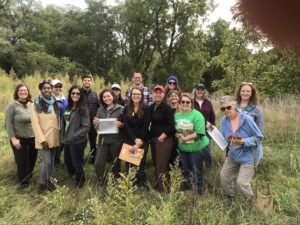
Beginning farmers need ag professionals’ help - which means ag professionals need to reach out to a demographic that may have never lived or worked on a farm, but want to learn. Marketing and educational strategies and their focus on community to help farmers get to know each other. Ag professionals will learn beginning farmer needs, working with the media, and how to work with land trust representatives and FSA staff to better understand the needs of beginning farmers and to help enhance their ability to initiate and maintain a farm operation.
Train farmers in mini-grant writing workshop, reaching out to underserved populations of veterans, beginning farmers, and BIPOC farmers.
Mini-grants are given to farmers who will train Ag professionals.
A farm tour to train ag professionals in the needs of beginning, underserved and diverse farmers.
Continue to create beginning farmer videos to be used for training.
Train ag professionals in diversity, equity, and inclusion.
Train farmers in mini-grant workshops in the summer 2021, 25 people attended the three workshops.
Mini-grants are given to farmers who will train Ag professionals. Four $2000 given to farmers who plan to train ag professionals in 2022.
A farm tour to train 15 ag professionals in the needs of beginning, underserved and diverse farmers. In In September 2021, farm tours happened in Indianapolis to meet two urban farmers sharing their farm and operations.
Continue to create beginning farmer videos to be used for training. Still working on the video editing.
Train ag professionals in diversity, equity, and inclusion. 3 webinars were created to invite our Extension educators, the SARE advisory council and other ag professionals. Over the course of the three webinars, we had 68 people attend them. They will be shared on youtube with closed captioning when that is finished.
Duncan worm Farm mini-grant 2022
This report is from Stephanie Duncan, "This project was to help provide education on Vermi-compost benefits and uses in all natural
organic gardening. I am quite pleased with the outcome. We held two workshops in
conjunction with the PUSH-IT program in January and one in March.
January 12, 2022 was held at Lincoln State park Sponsored by Spencer Co. SWCD. It focused
on Composting.
We had 25 people show up. I had a 15 minute presentation about Vermi-compost ,and how it is
obtained, the benefits of it in plant growth, pest deterrent and disease suppression. Everyone
seemed very excited about getting started in vermicomposting. I also brought a working worm
bin to show how one is set up. I then showed them worm castings, cocoons, worms
and bedding. There is nothing better than actually seeing a process versus just reading about it
online.
March 12th,2022 we held a How to Vermi-compost workshop, sponsored by Posey Co SWCD
and the PUSH-IT program. We had another great turn out of 23 people. I had a slide
presentation on how to compost with worms at home. With the help of Carrie Parimeter of
SWCD, Posey County we were able to provide each participant with a working compost bin to
take home. We set up stations to assemble a Continuous Flow Bin. The 1st station was to
drill air holes and Drainage holes in 5 Gallon buckets and lids. Everyone got two 5 gallon
buckets, the bottom bucket with no holes as drain catch. The 2nd and 3rd stations were for
adding worm bedding to their CFT. We had Peat moss, shredded cardboard , top soil and
crushed oyster shells. Participants got to measure out each product and then moisten with
water. They were able to see and feel the bedding to know for future how moist it should be.
The Last station was their red wigglers, approximately 350 worms. I had them in a 2 qt Organza
bag with some worm castings and bedding.
After we had all the composters assembled we took time to answer questions.
We had such a great response to this workshop.
I spoke with Carie Parimeter and she says she is still getting inquiries about when they would
hold another Vermi-composting workshop. The only thing we would do differently at any future
workshops would be to have a small fee to cover supplies for everyone making and taking
compost bins.
The money I was awarded helped Duncan Worm Farm to be able to attend the US Worm
business conference 2022. It helped offset the cost of airfare, car rental, hotel and registration.
The conference gave us hands-on learning of the processes of vermi-composting, worm
breeding, and applications of vermi-teas and extracts. We were able to bring back all this
knowledge and use it to help others with their own vermi-composting. There have been very
few educational venues available on vermi-composting in our rural counties. I believe there is a
need for more of these events in the future." Ag professionals of SWCD attended this educational event put on by the Duncan Worm Farm.
OFARM mini-grant and outcomes:
Mini-Grant Progress Report to Indiana SARE
Project Title: Strengthening OFARM – Preparing for the Future
John Paul Franks, Project Leader
Edward P. Reznicek (Central Plains Organic Farmers & OFARM board member)
Introduction.
This is a report and request for reimbursement to Indiana SARE regarding the 2022 Mini Grant titled, “Strengthening OFARM – Preparing for the Future”.
Activities to Date.
Introductory Planning Session. In September 2021 OFARM held a Strategic Planning Introductory session for OFARM and member co-op leaders. This session provided an overview of the purpose, process, outcomes and next steps for a strategic planning process. Since co-op leaders and participating members are spread across several states, the planning group decided to pursue the planning process through a series of virtual (zoom) meetings. The group also decided to pursue additional funding to help support and pay for the strategic planning initiative and set out a tentative planning schedule spanning a year long process.
Board and Executive Committee Discussions. The OFARM board of directors and planning participants continued to hold discussions around planning needs and processes. This group identified three strategic planning initiatives: (1) Improve co-op capacity building and education; (2) Develop a plan to expand strategic collaborations with other organizations; and (3) Strengthen co-op leadership and plan generational succession.
Member Survey – University of Wisconsin Center for Cooperatives. The OFARM board and planning participants also wanted to conduct a survey of farmer members who make up the cooperatives that make up OFARM. This group met with Kelly Maynard from the University of Wisconsin Center for Cooperatives to plan a member survey. OFARM and UWCC jointly constructed and implemented the survey during the Winter and Spring 2021 and 2022. UWCC issued the final report on the survey in late summer 2022. OFARM is using the survey results to shape the strategic planning process going forward.
Collaborative Grant Proposals. (1) In the spring of 2022 USDA announced new grant programs around the topic of Climate Smart Ag Commodities. OFARM and member co-op planning participants undertook a collaboration with other North Central Region organizations (Marbleseed, Ohio Ecological Food and Farming Association, The Michael Fields Institute and other partners) to plan and submit a grant proposal regarding organic field crop and forage production and marketing under the sub-program titled, “Climate Smart Agriculture and Forestry (CSAF). This project will advance organic production, cooperative marketing and soil health monitoring for organic field crops and forages. This collaboration aligned perfectly with OFARM and member co-op plans to expand collaborative initiatives to advance organic production and cooperative marketing. In December 2022 USDA announced the approval of this five year proposal. For OFARM, it’s member co-ops, and for organic farmers in Indiana and across the North Central region this means more opportunities and resources to improve and expand climate smart organic production and cooperative marketing.
(2) In the late Fall of 2022 OFARM and it’s member co-ops were invited to participate in another collaborative initiative to expand and improve organic production, marketing, capacity and community building. This is the USDA NOP Transition to Organic Production Partnership (TOPP) initiative, led by USDA selected certifying organizations. OFARM, member co-ops and some of the strategic planning participants will participate as partners with the Organic Crop Improvement Association (OCIA) in the Central Plains region and Midwest Organic Services Association (MOSA) in the Midwest region. This is another five year grant project to increase organic production and marketing, build farmer and service provider capacities and to strengthen organic communities across the U.S.
In the coming few months these initiatives will undergo more detailed planning and implementation with focus on organic farmer mentoring, technical assistance, marketing (including cooperative marketing), soil health monitoring along with other educational and capacity building activities. OFARM, member co-ops and farmer members will participate in the planning, implementation and program activities as these initiatives unfold over the coming five years.
Current Status of OFARM Strategic Planning.
OFARM’s initial strategic planning schedule was delayed due primarily to the CSAF and TOPP grant initiatives. Because of the prior planning experience of Central Plains Organic Farmers and OFARM’s ongoing planning activities, OFARM was well prepared to participate in the collaborative grant planning initiatives for both the CSAF and TOPP programs. These earlier planning activities prepared OFARM for knowing what it wanted and could contribute to the CSAF and TOPP programs.
This Fall and Winter OFARM resumed it’s more focused strategic planning. We have individual interviews underway, and OFARM will resume strategic planning zoom meetings in February 2023, with four zoom meetings scheduled between February and September 2023. One thing we learned by spreading out the strategic planning process, as opposed to strategic planning conducted in a 2-3 day marathon session, is that it gives you time to collaborate, implement and learn with some elements of the strategic planning even as the planning process is ongoing. This learning and experience also contributes to the still unfolding strategic planning process. This keeps planning participants engaged and experiencing concrete results from the planning.
Expense Reimbursement.
Included with this report is a paid invoice for $4,000 OFARM paid to Advancing Rural Prosperity for its services in leading and facilitating our strategic planning initiative. We request payment from Indiana SARE for the $2,000 it committed to this initiative. OFARM will provide additional reports as it continues its strategic planning and related activities.
John Paul Franks, Indiana organic farmer
Edward P. Reznicek, CPOF G.M. and OFARM Board Member
Educational & Outreach Activities
Participation Summary:
Learning Outcomes
Face of SARE
Sending new books to the newest Urban soil Health Regional Specialists, making sure new ANR educators learned about SARE, and sharing books to help their library grow, was important for FACE of SARE this year. The Student Farm at Purdue hosted a Veg day where SARE had a booth to meet farmers and share about SARE grants. A few Advisory council members took SARE materials and shared them at veteran events, which was great teamwork! Continuing to take calls to help farmers in the grant-writing process is very important. We also worked with grant writers to have a few webinars to help farmers in the mini-grant process. We want these farmers to feel comfortable trying for larger grants in the future.
